
Children's cosmetic market tipped to reach USD $32m globally by 2031. Identifying safe options for children.
Announcement posted by Oh Flossy 08 May 2024
In today's colourful world, the joy of playing with makeup is not just reserved for adults. As one of the leading kids makeup brands, Oh Flossy is spearheading a movement towards safe makeup for kids, ensuring that children can explore their creativity without compromise. Oh Flossy was established in 2018 and we're proud to be recognised by many industry awards for prioritising safety and fun in equal measure. We've made it our mission to offer hypoallergenic, non-toxic kids makeup options, perfect for kids with sensitive skin and crafted with natural ingredients, setting the standard in the kids' makeup industry.
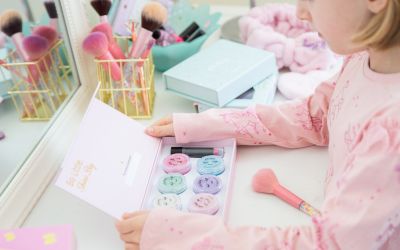
With the rise of kids' cosmetics, parents are increasingly facing the challenge of navigating the huge array of products to find kids makeup products that are not only playful and inspiring but also adhere to the highest standards of safety. The importance of choosing hypoallergenic makeup, makeup for kids that is non-toxic, and kid-friendly makeup sets has never been more critical. We delve into the essentials of kid-safe makeup, offering guidance on selecting the best kids makeup that champions natural ingredients and safety for our little ones.
The Rise of Children's Cosmetics
The children's cosmetics market has seen a remarkable surge in popularity, driven by various factors that resonate with modern parenting and lifestyle trends. Some of the dynamics propelling this industry forward include:
Market Growth and Influences
- Social Media's Role: The influence of social media platforms has significantly shaped the kids makeup market, with children and parents getting inspired by online trends and tutorials.
- Increased Disposable Income: As disposable income among parents rises, so does the expenditure on children's luxury and leisure products, including cosmetics.
- Themed Social Activities: The popularity of themed parties, costume events, and playdates has also contributed to the increased demand for children's cosmetics, making them essential accessories for these occasions.
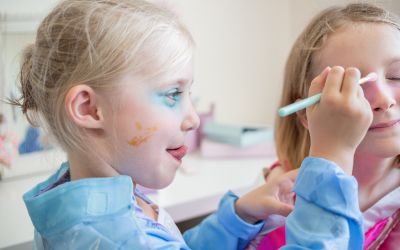
Consumer Behavior and Demographics
- Widespread Usage: Surveys indicate that approximately 79% of parents report that their children, aged 12 or younger, use makeup and body products specifically marketed to them [1].
- Frequency of Use: About 54% of these children use cosmetics at least monthly, with 12% using them daily. Remarkably, 20% wear these products for eight hours or more at a time, highlighting the importance of safe formulations [1].
- Diverse User Base: Cosmetics for children span a wide range of use cases including makeup used for dance concerts, gymnastics tournaments, parties or just to keep the kids entertained on a rainy weekend! [1].

Economic Impact
- Market Valuation: The global Children's Cosmetics market was valued at USD 20,044.26 million in 2022 and is projected to grow at a CAGR of 8.0%, reaching USD 31,811.59 million by 2031 [2].
- Leading Categories: The market segments into various product types such as Face Products, Eye Products, and Lip Products, with Eye Products emerging as the fastest-growing category [3].
This data not only underscores the expanding footprint of children's cosmetics globally but also highlights the critical need for stringent safety standards to protect young users [2][3].
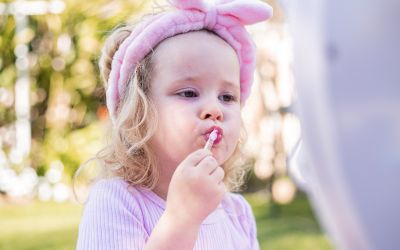
Health Risks and Safety Concerns
Traditional makeup products often contain hazardous substances like lead, phthalates, and formaldehyde, which pose significant health risks when absorbed through the skin.
Common Harmful Ingredients in Children's Makeup
- Lead and Asbestos: Found in some children's makeup, these substances are known carcinogens and can severely affect mental and physical development.
- Phthalates and Formaldehyde: Often used in cosmetics, these chemicals can disrupt hormones and cause other health issues.
- Talc in Powders: Talc can contain asbestos fibers, which are harmful when inhaled.
- Petroleum in Lip Products: These can introduce harmful hydrocarbons and other chemicals.
- Synthetic Fragrances and Colors: These can cause allergic reactions and long-term health effects.
Children are particularly vulnerable as their skin absorbs more of these harmful ingredients compared to adults. Also, the frequent application and accidental ingestion of makeup increase their risk of exposure.
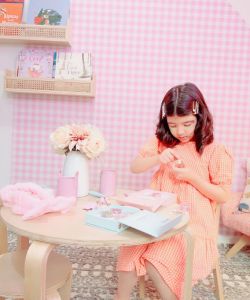
Regulatory Guidance and Safety Standards
The Council of Europe and other regulatory bodies have developed guidelines to mitigate health risks associated with children's exposure to cosmetics. For instance, the guide "Safe Cosmetics for Young Children" provides science-based guidelines aimed at manufacturers and safety assessors to ensure the safety of cosmetic products intended for children [4]. These standards are crucial in fostering a safe environment where children can enjoy cosmetics without risking their health. We've ensured that the Oh Flossy product range has met these strict standards to ensure the safety of our little customers. We've undertaken all required Stability Testing, EN71 Toy Safety Directive Testing and Cosmetic Product Safety testing.
Navigating Safety Standards and Regulations
Global and National Regulations
- International Guidance: The Council of Europe's European Committee for Cosmetics and Consumer Health (CD-P-COS) provides essential guidelines and technical standards, ensuring the safety of cosmetic products for all users, including young children [4].
- Science-Based Guidelines: The CD-P-COS guide for manufacturers and safety assessors (2nd Edition, 2023) offers comprehensive, science-based guidelines to identify and prevent health risks in children from cosmetic products [4].
- Mandatory Information Standards: The Consumer Goods (Cosmetics) Information Standard 2020 mandates clear labeling of cosmetic products, which plays a crucial role in preventing allergic reactions and ensuring consumer safety [5].
Enhanced Labeling Requirements
- Ingredient Listing: It is now mandatory for cosmetic companies to list all ingredients on product labels, helping consumers make informed choices [6] [5].
- Special Marks for Children's Cosmetics: Labels on children's cosmetics must include specific marks and warning words to ensure they are not mistaken for food or drugs.
Enforcement and Compliance
- ACCC's Role in Australia: The Australian Competition and Consumer Commission (ACCC) conducts regular surveys to detect products that fail to comply with safety standards, ensuring that non-compliant goods are penalized [7].
- Penalties for Non-Compliance: Supplying goods that do not meet mandatory information standards can lead to significant penalties under the Trade Practices Act 1974 [7].

The Role of Industry in Promoting Safety
To ensure the safety and health of young users, the cosmetics industry plays a pivotal role by developing products that are both fun and safe for children. Here's how industry leaders are setting standards:
Specialised Safe Brands
- Focus on Specialisation: Brands such as Oh Flossy specialise in creating makeup that is safe and age-appropriate for children.
- Product Features: Oh Flossy offers products that are hypoallergenic, vegan, cruelty-free, and made in Australia. Our formulations are designed to be non-toxic, safe, and easy to wash off, catering specifically to the needs of young skins.
Emphasis on Non-Toxic Ingredients
- Natural Ingredients: We incorporate ingredients like cocoa butter, castor oil, peach kernel oil and, vitamin E in our products, which are known for their nourishing and protective properties.
- Avoiding Harmful Chemicals: It is crucial for brands to avoid chemicals that could cause harm, focusing instead on natural and safe ingredients.
By prioritising these aspects, the cosmetics industry not only ensures the safety of its youngest consumers but also builds trust with parents looking for safe and fun makeup options for their children. Read more in our previous article about what to look for in the ingredients within children's cosmetics.

Tips for Parents: Choosing Safe Makeup for Children
Essential Criteria for Selecting Kid-Friendly Makeup
- Prioritise Natural and Organic Ingredients: Opt for makeup products that include natural oils, butters, and waxes, which are gentler on children's skin. Avoid products containing parabens, lead, synthetic fragrances, formaldehyde, talc, and mineral oil as these can be harmful. Read our blog on our natural lip gloss which highlights the natural ingredients we use in our kids lip gloss range.
- Check for Hypoallergenic and Non-toxic Labels: Ensure that the makeup is specifically labeled as hypoallergenic and non-toxic. These products are formulated to minimise the risk of allergic reactions and are safer for children's delicate skin.
- Age and Skin Sensitivity Considerations: Choose products that are appropriate for the child's age and skin type. Consider any known allergies and personal preferences to avoid skin irritations and ensure comfort.
- Educate on Safe Application Practices: Teach children the importance of using clean applicators, not sharing makeup, and maintaining good skincare habits like moisturising and staying hydrated.
- Test Before Full Application: Always conduct a patch test with new products on a small area of the skin before full application to check for any adverse reactions.
- Awareness of Greenwashing: Be vigilant of 'greenwashing', where products are marketed as natural or eco-friendly without valid certifications. Check and understand labels thoroughly.
- Brand Trustworthiness: Choose cosmetics from reputable brands known for producing child-safe products free from harmful substances like heavy metals and phthalates.
- Set Playtime Boundaries: Explain to children that makeup is for playtime only, to prevent misuse. Supervise their use and ensure proper cleanup after play to maintain skin health.
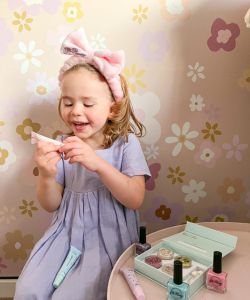
Final Thoughts
We've highlighted essential tips and insights for parents seeking to navigate the complex world of kids' cosmetics. By delving into the critical aspects of regulatory standards and health concerns, we've underscored the importance of selecting hypoallergenic, non-toxic makeup for the youngest members of the family. The role of the cosmetics industry in promoting safety, alongside parents' vigilant choice-making, emerges as paramount in safeguarding our children's health while allowing them the joy and creativity makeup can bring.
As we look towards the future, the increasing demand for children's cosmetics calls for continuous vigilance and responsibility from both manufacturers and consumers. The implications of our choices today will significantly impact the well-being of our children and the ethical standards of the cosmetics industry at large. By adhering to the guidelines provided, encouraging further research, and choosing products with care, parents can ensure a safer, more joyful play experience for their children, fostering an environment where fun and safety go hand in hand.
